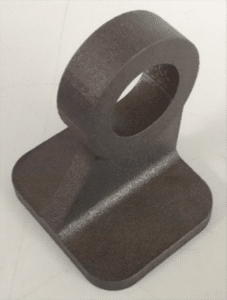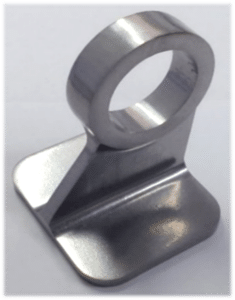
AM-manufactured bracket before Almbrite treatment
It’s well-known that industrial developments in the aerospace arena take a long time, but as a leading West Country surface treatment specialist can attest, the end result makes the effort worthwhile.
The R&D team at South West Metal Finishing (SWMF) knew they had a potential winner when they started developing an innovative process to improve the surfaces of components manufactured using additive layer manufacturing (ALM or AM).
That was in 2014, and the disruptive technology of AM itself was in its early days, especially for aerospace applications.
SWMF realised that the complexity possible with AM design called for a revolutionary approach to post-production surface treatment. So, building on its extensive experience in surface coatings and treatments, the Exeter-based specialist set to work on a new chemical immersion treatment to enhance the surface of AM parts. “We call it ‘chemical milling’,” said Sean Hammond, Group Director of Sales and Marketing. The industry knows it as Almbrite™.
Three years into development, NATEP gave SWMF the opportunity in 2017 to test Almbrite™ in an industrial setting as the industry partner in Project Fusion, an 18-month project led by Bristol-based AVPE with Airbus as the end-user.
Typhoon and Tempest
The objective of Project Fusion was to develop Airbus-certified Class 2 components manufactured using AM technology with modified post-AM machining, non-destructive testing (NDT) and surface treatment processes.
And now, five years after Project Fusion’s successful completion, Almbrite™ is a patented process that has taken SWMF onto some of the biggest current and future programmes, including the Eurofighter Typhoon and more recently the next-generation Tempest project, which is expected to make heavy use of AM parts.
In addition, the company is working with two major manufacturers of AM powders and machines on a test programme to develop the Almbrite™ process for more materials.
Receiving patents was ‘massive’
Hammond said receiving patents for the process earlier this year was “massive for us”. It has led to expansion of SWMF’s own capacity at its Marsh Barton site in Exeter. The company plans to license the process where applicable.
The Almbrite™ process comes into its own with near-net-shape AM parts whose sealing faces must be machined to fine tolerances for fitting and joining. Almbrite™ can achieve an average roughness (Ra) of 3.2 microns on titanium and aluminium parts. Bettering that is possible, said Hammond, but can be a challenge.
With complex parts, such as heat exchangers, whose internal and external surfaces have the same roughness, being able to pump the solution through the object, however fine the bore is, allows that surface to be smoothed, reducing the chance of turbulence in gas or air flows and regaining “anything from 70-80% of a part’s fatigue life”.
Attractive to manufacturers
That’s a key advantage, he said, and probably one of the most attractive things to manufacturers.

AM-manufactured bracket after Almbrite treatment
“That means either the part as designed has better fatigue life, or the desired fatigue life based on surface finish originally catered for is enhanced, so designers might be able to make a thinner wall section or design it differently to reduce weight or material usage or both.
“Forget aesthetics: from the point of view of mechanical advantage, this has to be one of key elements to having a process such as this.”
Since its involvement in the NATEP project, SWMF has seen the uptake of its now-patented process by various top-tier aerospace manufacturers, while others, including the “F1 fraternity”, are interested. And it will only increase, Hammond predicts, as the use of AM itself expands.

